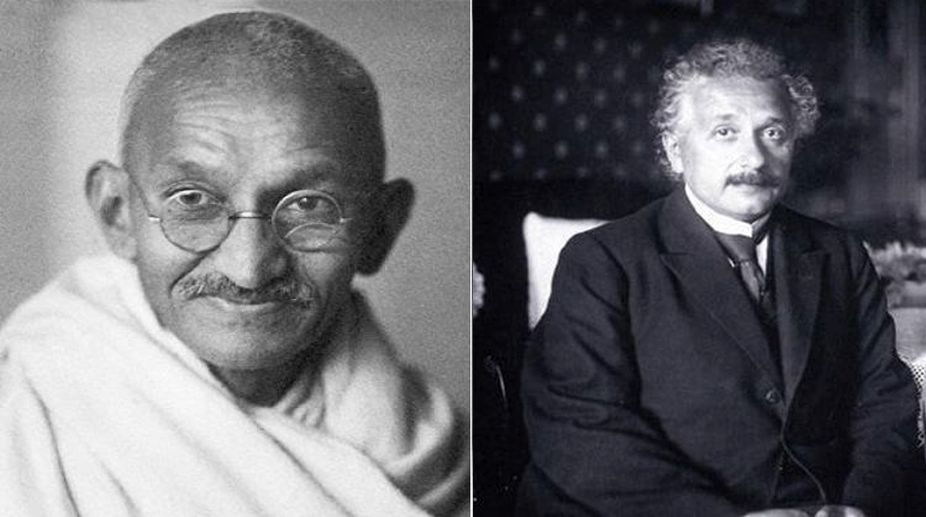Satyagraha excludes the use of violence in any shape or form, whether in thought, speech, or deed. Given a just cause, capacity for endless suffering and avoidance of violence, victory is a certainty
~ Mahatma Gandhi
Advertisement
Time magazine named Albert Einstein as its Man of the 20th century and Mahatma Gandhi as joint runner-up with Franklin D Roosevelt. Curiously, there remains a striking parallel between the constraints faced by the two outstanding personalities.
Einstein confronted an ‘inviolable constraint’ ~ the experimentally proven fact that the velocity of light in vacuum remains unchanged in a moving frame of reference. He ultimately succeeded in reformulating the laws of Newtonian mechanics by invoking a previously unthinkable requirement of mass, length and time-change in a moving frame of reference.
Thus was born the Special Theory of Relativity and a new era emerged in physics. Einstein’s goals were achieved through the analytical power of mathematical relationships and his explanations and hypotheses have also been tested by the validating power of experiments.
As a parallel, Gandhi confronted the oppression of the British in India and wanted to bring it to an end with the ‘inviolable constraint’ of non-violence.
A scientist is a dreamer and so is a revolutionary. Gandhi was both a scientist and a revolutionary. He was indeed an ‘evolutionary scientist’.
Traditionally, people have relied on rational discussion and violence, appealing respectively to reason and the ‘body-force’. In Gandhi’s reckoning, both methods were unsatisfactory in varying degrees.
He pulled out Truth and Non-violence from the dreary pages of philosophical treatise and transformed them into a dynamic concept by devising ideas and methods that had not been thought of or practised earlier. He explored a force that relied on the hitherto untapped ‘soul-force’ or ‘truth-force’ and also coined the term satyagraha as the name for the unique force.
Indeed, satyagraha is the sumtotal of the Life Message of Gandhi, the revolutionary social scientist. As he forged ahead on the path of satyagraha, in another corner of the world, Albert Einstein was observing the experiments being carried out in the laboratory by another scientist ~ Mahatma Gandhi.
On 27 September 1931, Einstein wrote to Gandhi openly expressing his admiration for successfully leading the Salt Satyagraha ~ “You have shown that we can achieve the ideal even without resorting to violence.
We can conquer those votaries of violence by the non-violence method. Your example will inspire humanity to put an end to a conflict based on violence with international help and cooperation, guaranteeing peace of the world. With this expression of my devotion and admiration I hope to be able to meet you face to face.”
Satyagraha is Gandhi’s greatest gift to mankind. Etymologically, the term means passion for, or firmness in Truth satya in Sanskrit means Truth and agraha denotes passion or firmness.
In his own words, Satyagraha is literally holding on to Truth and it means, therefore, Truth-force. Truth is soul or spirit. It is, therefore, known as soul-force’. Through heroic and solitary experiments Gandhi arrived at his radiant discovery of the power of collective non-violence, which evolved in time into the weapon of satyagraha.
On 11 September 1906, Gandhi opened the path of emancipation for the suffering humanity with the weapon of satyagraha.
Indians gathered at the Empire Theatre of Johannesburg and swore not to obey the proposed anti-India Ordinance, if it became a law. It was the beginning of one of the most significant experiments which held out considerable hope for the world ~ the experiment based on Truth and nonviolence.
In South Africa, Gandhi realised that the English term ‘passive resistance’, which is largely derived from the Christian concept of non-resistance to evil, failed to express the nature of non-violent resistance in the form developed by him.
To distinguish satyagraha from passive resistance, Gandhi said, ‘While in passive resistance there is scope for the use of arms when a suitable occasion arrives, in satyagraha physical force is forbidden even in the most favourable circumstances. Passive resistance is often looked upon as a preparation for the use of force, while satyagraha can never be utilised as such.
It destroys ‘hatred with non-hatred, violence with nonviolence’, by inviting the opponent to inflict injury and suffering upon the satyagraha. It emphasises the continuous cleansing of the mind. “Mere non-violence does not make any campaign a satyagraha.
It should be nourished by truth and love. It is founded on a clinical attitude to life. Gandhi first learnt the lessons of satyagraha from his family life. In his Autobiography he admits: ‘I learnt the lesson of non-violence (Satyagraha) from my wife. I tried to bend her to my will.
Her determined resistance to my will on the one hand, and her quiet submission to suffering my stupidity involved on the other, ultimately made me ashamed of myself and cured me of my stupidity in thinking that I was born to rule over her; and in the end she became my teacher in nonviolence.’
Moreover, there was a confluence of different influences which came together, as if by a hand of destiny, and guided Gandhi to mould the instrument of satyagraha.
Hence a Gujarati hymn from India, a New Testament from Palestine, a book from Russia, a pamphlet from America, the Suffragette influence from Britain, and then two men in South Africa ~ a coach attendant and a white occupant of a waiting room, one of his own brethren whose cause he was fighting for and, above all, a poor illiterate Indian peasant who stood waiting to take him to Champaran where he conducted his experiments in satyagraha in the political laboratory in India for the first time in 1917.
All these influences came together to lead Gandhi, as if by a hand of destiny, into the battlefield of the 20th century to wage one of the noblest battles for the liberation of mankind.
Beginning in South Africa, Gandhi launched satyagraha against the laws of the Transvaal government, which required every Indian to procure a certificate of registration or face deportation. Another set of South African laws declared Hindu, Muslim and Parsee marriages illegal.
Gandhi’s movement led to the abrogation of such repressive laws. On his return to India in 1915, after 21 years in South Africa, the Mahatma tested the technique in the district of Champaran in North Bihar in April 1917. He applied the weapon to fight for the indigo farmers.
Under British rule, farmers in Champaran were made to cultivate indigo on 2/20th of their holdings (known as the satyagraha system) and the crop was bought at throwaway prices for textile mills in Britain. It was one of the darkest chapters of colonial exploitation.
The method of satyagraha was also used to settle the dispute between textile mill owners and labourers in Ahmedabad. In the age of violence we hardly understand the import of satyagraha. It continues to be diversely interpreted leading to doubt and confusion.
When South Africa is cited, it is brushed aside as an event that was possible on a small-scale, not applicable to a continent-sized country like India. In a similar way, Champaran, Ahmedabad, Kheda and Borsad are also undermined. What we really need is to understand satyagraha within its limits of satya and its concomitant, Ahimsa.
As a major proponent of peace, Mahatma Gandhi warrants serious attention both for his ideas of satyagraha and for his experiments with the same.
As Martin Luther King Jr. aptly said, ‘The choice today is no longer between violence and non-violence. It is between either non-violence or non-existence’.
The writer is a retired IAS officer.











